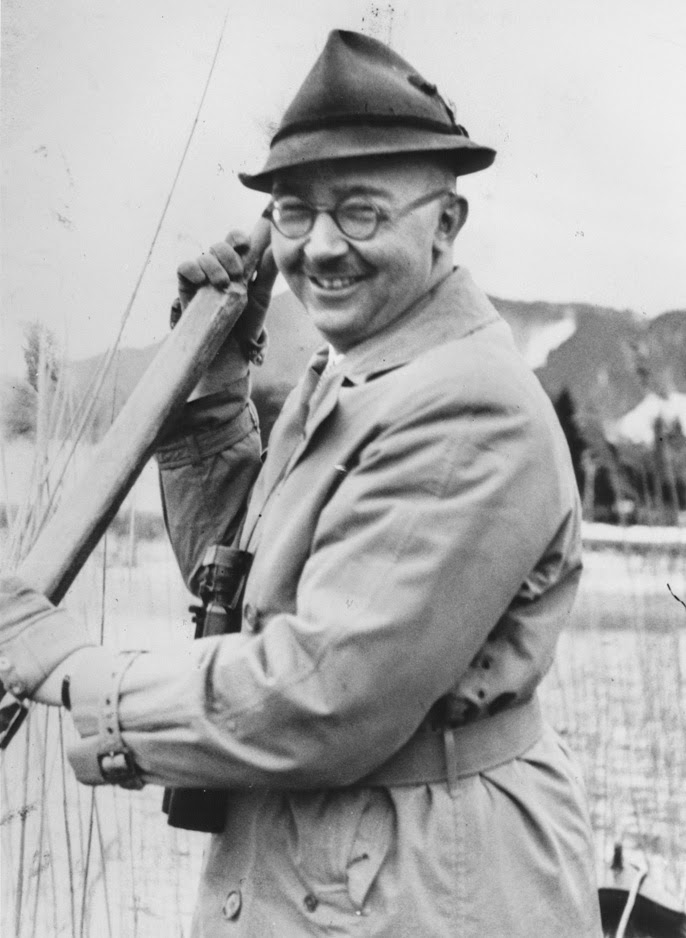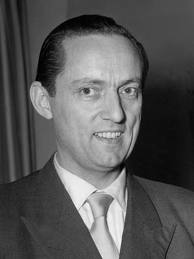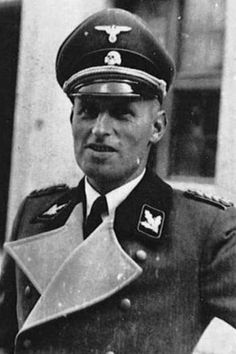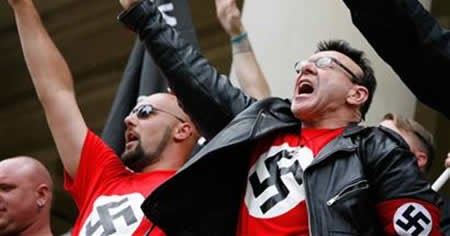
The name of the book speaks for itself: “The Unlikely Death of Heinrich Himmler”. It was written based on interviews with key individuals (doctors, dentists, military officers and NCOs) who personally witnessed the events of “Himmler’s death” on May 23rd, 1945.
The first discovery made by W. Hugh Thomas was nothing short of astounding. It turned out that the British authorities did not let Heinrich Himmler (or whoever impersonated him) rest in peace. Well, they did – but only for mere eight months.
In January of 1946 the body of whoever was buried on Lüneburg Heath was completely out of the blue exhumed (finding a grave was a genuine miracle as it was too well-concealed) and a second thorough post-mortem examination was conducted.
Another genuinely shocking fact uncovered by W. Hugh Thomas was that the British brought with them… the former SS-Brigadefuhrer (Brigadier General) Walter Schellenberg. With but one objective – officially identified the remains as those of his former boss Heinrich Himmler.
Which can lead to one and only one conclusion – some reason the British authorities began to seriously suspect that the SS-Reichsfuhrer had cheated death and had duped then (and I do not know what of these two infuriated them more).
Apparently, the former head of Ausland-SD (RSHA Amt VI) either failed to positively ID the body as that of Heinrich Himmler, or worse, categorically stated that the remains were NOT of his former boss.
The second result appears far more likely as (1) after this exhumation, subsequent second autopsy and the re-burial of the body British inquiries into Himmler’s death continued; and (2) a lot of the documents pertaining to the whole “Lüneburg incident”, were classified “Top Secret” and forbidden from being made public for 100 (!) years. In other words, until June of 2045 (I still hope to be around when they are declassified).
However, there is one very much public statement about the incident that speaks volumes about its essence. Incredibly, the only official statement on the burial of Heinrich Himmler was made not by a general (which would have been expected given the rank and status of the deceased) or even the junior officer, but by an NCO – the Colour Sergeant Major Edwin Austin (the first word had nothing to do with the color of his skin – it was simply a senior NCO rank established in 1813):
“I wrapped him in a couple of blankets, I put two of our army camouflage nets around him and tied him up with telephone wires. I put the parcel on the back of the truck and drove off. I had to dig the grave myself. No one will ever know where he is buried.”
There was a little problem with that statement, however. CSM Austin did not have a driver’s license. He could not drive even a car – let alone a military truck…
What does this statement tell us? IMHO, just one thing – the first autopsy provided some serious evidence that the deceased was NOT the SS-Reichsfuhrer. However, the commanding officer in charge of the whole thing – one Colonel L. M. Murphy – has already made a report to his superiors that Heinrich Himmler was captured, detained, arrested, identified and committed suicide.
For obvious reasons, the abovementioned Colonel had no desire to admit his mistake. So he predictable engineered a cover-up which was entrusted to the fiercely loyal Sergeant Major (in the U.S. Armed Forces it is widely – and correctly – believed that if you want something done quickly and efficiently, a sergeant major can always be trusted).
And not just something, but anything. Anything at all. Including covering up a blunder of genuinely galactic proportions.
Another incredible fact was uncovered by W. Hugh Thomas in a seemingly totally unexpected place. Jerusalem. In the documents related to the trial of Adolf Eichmann – one of the key perpetrators of the Holocaust.
In 1961, when Eichmann stood trial for his role in this possibly the most horrendous act of genocide in human history, the Mossad (the Israeli equivalent of CIA or MI-6) was focused squarely on ensuring the survival of Israel and thus could allocate few (if any) resources to hunting the Nazi criminals – no matter how many Jewish deaths they were responsible for. Initially they were reluctant to go after even Adolf Eichmann.
Still, the capture and trial of the latter provided the Mossad with an opportunity too good to ignore. So a decision was made to – directly and indirectly, explicitly and implicitly, openly and clandestinely – question Eichmann about the whereabouts of other Nazis known to have committed crimes (mass murders – let’s be blunt) against the Jews.
It took a lot of time and effort (as Eichmann was not exactly cooperative and torture – for many reasons – was out of the question), but finally the Mossad interrogators came up with a four-page list.
The names on the list were divided into three categories – those war criminals who had disappeared entirely (headed ‘Disappeared’), those war criminals arrested previously, under the heading (‘Arrested’), and those war criminals free after arrest (listed as ‘Free’).
Half down the last page there is a critical entry. Under the title ‘Anomalous’ it says: ‘Eichmann tps 3, 4 – Reichsführer Heinrich Himmler, alive Germany? There can be only one explanation for this entry – for some unknown reason Eichmann believed that Himmler was still alive in 1961 – despite the apparently accepted historical fact of Himmler’s suicide in British hands.
As I have already mentioned, Mossad had far more important things to do (e.g. saving Israel from annihilation and its citizens from the “Holocaust II”) than chasing such a nebulous lead. So no one pursued it – and Eichmann took his reasons (and thus possibly the mystery of Himmler’s disappearance) with him to his grave.
Another Nazi criminal – the infamous Butcher of Lyon’ Klaus Barbie just prior to his death in 1991, began making unsubstantiated but nevertheless interesting statements about Himmler’s survival that echoed (and even rivaled) those of Eichmann.
The Eichmann entry on Himmler contained one more piece of information that could be crucial for solving the mystery of his whereabouts immediately after the surrender of Germany. This piece of information consists of exactly one word: Lorenz.
Which might point to a very specific (and powerful) individual – SS Obergruppenführer Werner Lorenz, Himmler’s personal friend (one of the very few) and at the time a commanding officer in charge of defending the of the north-west region of Germany. This region included the port of Hamburg – a convenient place to leave Germany for Spain or Latin America.
Lorenz had highly valuable business connections which would come quite handy after the war – one of his daughters (Jutti) was married to Count Kinkelbusch, who owned one of the biggest wine businesses in Germany, and his other daughter (Rosemarie), became the wife of a famous publisher Axel Springer.
His close neighbor, Hubert von Blücher, who held a Swedish passport and was at the time busily engaged in stashing away some of Himmler’s gold bullion. And American intelligence in the immediate aftermath of war, concluded that Hamburg was the kernel and headquarters of a well-established SS network. Which made the city a comfortable hiding place for someone like Himmler.
However, there is an even better candidate – not a person, but a company. Lorenz AG was a German subsidiary of the giant American company ITT. Ownership was disguised through a holding company, European Standard Electric, arranged by none other than the German firm Albert and Westrick in co-operation with their business partner Allen Dulles (!!).
Because Spain’s leader, General Franco, encouraged talented Germans to move to his country, the Spanish branch of Lorenz AG was considered by the SS to be the most important “ratline”. It also helped (and helped a lot) that the head of Spanish police was Himmler’s close friend.
This explanation is far more likely for another reason – as is evident from the Red House report, Himmler’s long-term objective was to invest the capital siphoned off the dying Third Reich into building a Fourth Reich that would arise, phoenix-like, from the skeleton of the SS ‘state within a state’, to be governed by a hard core of the élite. Hence, it made perfect sense to use a business entity in a neutral country as the “escape vehicle”.
Use of the “Spanish channel” made a lot of sense for another reason. The best “escape cover” was a cassock and a “dog collar” of a Catholic priest (there is little if any doubt that Himmler could have easily obtained either a genuine or at worst perfectly forged Vatican or Swiss passport and an ID that identified him as an employee of a Vatican organization that helps displaced persons). Spain was a practically 100% Catholic nation so a priest was highly revered and would not have been questioned.
It is also possible that in reality is was “double Lorenz” as the safest escape from Germany at the very end of the war (and right after) was – incredibly – by air. More specifically, by using one of the planes of KG 200 – a top-secret special ops Luftwaffe unit (they specialized – among other things – in dropping agents behind the enemy lines) based near Flensburg – in the area controlled by Werner Lorenz (and right where the government of the “funeral director” Karl Dönitz was based).
It flew all kinds of aircraft, including captured B-17s and B-24s which were immune to interception by Allied fighters and was under operational control of Himmler’s RSHA (more specifically, Schellenberg’s Amt VI, not the Luftwaffe).
By the time Allied investigators caught up with K G200, all the aircraft they would admit to were back at Flensburg. There was no way of knowing where they had been during the last few days of the Reich, although the Americans suspected most journeys had been to Spain.
It is also a well-documented fact that Werner Baumbach – KG 200 commander and the man in charge of all special ops of the Luftwaffe at the very end of the war was recalled from frontline operation and (by Himmler’s direct order) tasked with evacuating high-ranking Nazis.
Baumbach went ‘missing’ for a critical period of about two weeks, his whereabouts unknown. After the war, Baumbach spent three years as a prisoner of war before he moved to Argentina (!) where he worked as a test pilot. He (very conveniently) died in a plane crash on October 20th, 1953.
In other words, at the end of the war Himmler had at his disposal the best specialist escape squadron available in the world, its leader personally available to serve his Reichsführer, ready and waiting at a critical time.
Baumbach received the Knight’s Cross of the Iron Cross with Oak Leaves and Swords for the destruction of over 300,000 gross register tons (GRT) of Allied shipping – which gives some idea about his competence as a pilot.
Hence, he most likely (right after obtaining two U-boats for moving a load of valuables to South America) boarder a B-17 or B-24 with American markings and – disguised as a catholic priest with either genuine or perfectly forged documents of the Holy See flew to Spain (most likely, illegally – he had no desire to have any conversation with the Spanish border guards – no matter how sympathetic).
By that time he already had all necessary infrastructure in Spain – including the services of a highly plastic surgeon and a new set of documents (most likely, genuine Swiss passports).
After spending a few months in Spain, he most likely moved to one of the German-speaking cantons in Switzerland (most probably to Bern or Zurich) which would become the interim headquarters of Die Neue SS. After spending several years there, he most likely moved to Germany (IMHO, during the Neumann Affair he was already in his home country).
 There is strong (albeit still circumstantial) evidence that Die Neue SS made an attempt to take over Germany in 1953. West Germany, to be more precise. This incident even got a name – The Naumann Affair – after a German politician who allegedly was a mastermind of this (unsuccessful) plot.
There is strong (albeit still circumstantial) evidence that Die Neue SS made an attempt to take over Germany in 1953. West Germany, to be more precise. This incident even got a name – The Naumann Affair – after a German politician who allegedly was a mastermind of this (unsuccessful) plot. Up until the very last days of the Third Reich the officially designated successor to Adolf Hitler as the Führer of Germany was Reichsmarschall Hermann Wilhelm Göring (this rank – created specifically for him – gave him seniority over all officers in Germany’s armed forces).
Up until the very last days of the Third Reich the officially designated successor to Adolf Hitler as the Führer of Germany was Reichsmarschall Hermann Wilhelm Göring (this rank – created specifically for him – gave him seniority over all officers in Germany’s armed forces). Somehow, the British got wind of this meeting (before it actually happened) and predictably did not like it one bit. So on the night of the meeting – for the first time since the beginning of the war – the RAF bombed the shit (pardon my French) out of the city – specifically targeting the Maison Rouge Hotel. However, by the time of the bombing, the meeting was long over and its attendees were long gone.
Somehow, the British got wind of this meeting (before it actually happened) and predictably did not like it one bit. So on the night of the meeting – for the first time since the beginning of the war – the RAF bombed the shit (pardon my French) out of the city – specifically targeting the Maison Rouge Hotel. However, by the time of the bombing, the meeting was long over and its attendees were long gone. According to the “official version” of events, Heinrich Luitpold Himmler committed suicide on May 23rd, 1945 while in British custody. The (in)famous historian David Irving (who at the time of this book being written was still working on mammoth biography of SS Reichsfuhrer) claimed in his lectures that he has some serious evidence that Himmler did not commit suicide but was murdered by his British captors in a bout of uncontrollable rage. Which (a bout of rage, I mean), I find entirely possible.
According to the “official version” of events, Heinrich Luitpold Himmler committed suicide on May 23rd, 1945 while in British custody. The (in)famous historian David Irving (who at the time of this book being written was still working on mammoth biography of SS Reichsfuhrer) claimed in his lectures that he has some serious evidence that Himmler did not commit suicide but was murdered by his British captors in a bout of uncontrollable rage. Which (a bout of rage, I mean), I find entirely possible. Adolf Hitler was a quintessential Army man. Hence, he viewed his civilization – the Third Reich – as a mammoth army; the army that was fighting an existential war with Judeo-Bolshevism and its army – the mighty Soviet Union. Predictably (for him) the latter was supported by “capitalist liberal democracies” of the USA, Britain and their allies – controlled by the Jews, no doubt.
Adolf Hitler was a quintessential Army man. Hence, he viewed his civilization – the Third Reich – as a mammoth army; the army that was fighting an existential war with Judeo-Bolshevism and its army – the mighty Soviet Union. Predictably (for him) the latter was supported by “capitalist liberal democracies” of the USA, Britain and their allies – controlled by the Jews, no doubt. At the end of June, 1944, it was painfully (in a very literal sense) obvious to Heinrich Himmler (de-facto the second most powerful individual in Nazi Germany outside of Wehrmacht High Command) that the war could end only in a total disaster for Germany.
At the end of June, 1944, it was painfully (in a very literal sense) obvious to Heinrich Himmler (de-facto the second most powerful individual in Nazi Germany outside of Wehrmacht High Command) that the war could end only in a total disaster for Germany. Another prominent Nazi who may or may not have died in May of 1945, was SS-Obergruppenfuhrer Hans Kammler. He had an advanced degree in civil engineering by- he received his Doctorate in Engineering at the age of 31 – thus it is no surprise that he was put in charge of the key construction projects for the SS.
Another prominent Nazi who may or may not have died in May of 1945, was SS-Obergruppenfuhrer Hans Kammler. He had an advanced degree in civil engineering by- he received his Doctorate in Engineering at the age of 31 – thus it is no surprise that he was put in charge of the key construction projects for the SS.
 Contrary to a popular misconception, Neo-Nazis are fundamentally different from the original ones. The latter were national-sociopaths and, therefore, were driven primarily by deep, sincere and passionate (albeit not always efficient) love for their country and their people (although they did hate – and no less passionately – their real and perceived enemies).
Contrary to a popular misconception, Neo-Nazis are fundamentally different from the original ones. The latter were national-sociopaths and, therefore, were driven primarily by deep, sincere and passionate (albeit not always efficient) love for their country and their people (although they did hate – and no less passionately – their real and perceived enemies).